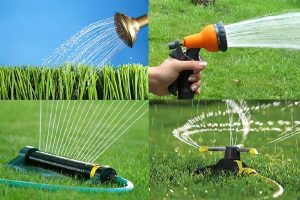Lawn watering what you need to know
When it comes to lawn watering, there are a few key things you should know to ensure your lawn stays healthy and green:
- Watering frequency: Lawns generally need around 1 inch of water per week, which can come from rainfall or watering. It’s best to water deeply and infrequently, rather than frequently with light watering, as this promotes deep root growth and a stronger lawn. In general, lawns should be watered 1-2 times per week, depending on the climate and time of year.
- Timing: The best time to water your lawn is in the early morning, when temperatures are cooler and the sun is not yet too strong. This reduces water loss from evaporation and allows the grass to absorb water before the heat of the day. Avoid watering at night, as this can promote disease.
- Amount: Aim to give your lawn around 1 inch of water per week, either through rainfall or irrigation. You can measure this by placing a rain gauge or a shallow container in your yard and checking the water level after watering.
- Irrigation methods: There are several ways to water your lawn, including using a sprinkler system, hose, or watering can. Choose a method that works best for your lawn and watering needs.
- Water conservation: Be mindful of water conservation and avoid over-watering your lawn. You can also consider using drought-tolerant grasses and landscaping, and installing a rain barrel to collect rainwater for use in your lawn and garden.
By following these tips and being mindful of your lawn’s watering needs, you can help ensure a healthy, green lawn.
When and how to water the lawn
Watering your lawn correctly is important for maintaining a healthy and green lawn. Here are some guidelines for when and how to water your lawn:
- When to water: The best time to water your lawn is in the early morning, between 4 a.m. and 10 a.m. This allows the water to soak into the soil before the sun gets too hot and evaporates it. Watering in the late afternoon or evening can lead to moisture on the grass blades, which can promote fungal growth and disease.
- How much to water: It’s important to water your lawn deeply and infrequently, rather than frequently with light watering. This promotes deep root growth, which makes the grass more resilient to drought and other stress factors. Aim for about 1 inch of water per week, including rainfall, and water your lawn 1-2 times per week, depending on the climate and time of year.
- How to water: There are several ways to water your lawn, including using a sprinkler system, hose, or watering can. If using a sprinkler, make https://sbevolutionlandscape.com/ sure it’s properly adjusted so that water is distributed evenly across the lawn. It’s best to water for longer periods of time, such as 30-45 minutes, rather than shorter periods, to allow the water to soak into the soil.
- Water conservation: Be mindful of water conservation and avoid over-watering your lawn. You can also consider using drought-tolerant grasses and landscaping, and installing a rain barrel to collect rainwater for use in your lawn and garden.
By following these guidelines, you can help ensure that your lawn stays healthy and gree
The main principles of irrigation
The main principles of lawn watering are:
- Watering frequency: Lawns generally need around 1 inch of water per week, which can come from rainfall or watering. It’s best to water deeply and infrequently, rather than frequently with light watering, as this promotes deep root growth and a stronger lawn. In general, lawns should be watered 1-2 times per week, depending on the climate and time of year.
- Timing: The best time to water your lawn is in the early morning, when temperatures are cooler and the sun is not yet too strong. This reduces water loss from evaporation and allows the grass to absorb water before the heat of the day. Avoid watering at night, as this can promote disease.
- Amount: Aim to give your lawn around 1 inch of water per week, either through rainfall or irrigation. You can measure this by placing a rain gauge or a shallow container in your yard and checking the water level after watering.
- Irrigation methods: There are several ways to water your lawn, including using a sprinkler system, hose, or watering can. Choose a method that works best for your lawn and watering needs.
- Water conservation: Be mindful of water conservation and avoid over-watering your lawn. You can also consider using drought-tolerant grasses and landscaping, and installing a rain barrel to collect rainwater for use in your lawn and garden.
By following these principles, you can help ensure that your lawn stays healthy and green while conserving water.

How to produce irrigation
Watering the lawn properly is important to ensure healthy and green grass. Here are the steps to follow when watering your lawn:
- Determine the watering needs of your lawn: The amount of water your lawn needs depends on several factors, including the type of grass, soil type, and weather conditions. As a general rule, lawns require about 1 inch of water per week, including rainfall.
- Choose the right watering method: You can water your lawn using a sprinkler system, hose, or watering can. Choose a method that is appropriate for the size of your lawn and your watering needs.
- Water in the early morning: Water your lawn early in the morning, before the sun gets too hot. This will allow the water to soak into the soil before it evaporates. Avoid watering during the middle of the day or in the evening, as this can increase the risk of disease.
- Water deeply and infrequently: Water your lawn deeply and infrequently, rather than frequently with light watering. This will encourage deep root growth and a healthier lawn. Aim to water your lawn once or twice a week, depending on weather conditions.
- Water evenly: Ensure that the water is distributed evenly across the lawn to prevent overwatering or underwatering in certain areas. Pay attention to any slopes or areas where water may pool and adjust your watering accordingly.
- Check for signs of overwatering or underwatering: Overwatering or underwatering your lawn can cause damage to the grass. Signs of overwatering include yellowing or wilting of the grass, while signs of underwatering include dry, brown patches of grass.
By following these steps, you can help ensure that your lawn stays healthy and green.
How often to water the lawn
The frequency of watering your lawn depends on various factors such as the type of grass, climate, soil type, and time of year. As a general rule, it’s better to water deeply and infrequently than to water lightly and frequently. This encourages deep root growth and helps make the lawn more resilient to drought.
Here are some guidelines for how often to water your lawn:
- New Lawns: Newly seeded or sodded lawns need to be watered more frequently until they establish deep roots. Water them daily or every other day for the first few weeks until the grass is established. After that, you can reduce the frequency of watering.
- Climate: If you live in a hot and dry climate, you may need to water your lawn more often than if you live in a cooler, more humid climate. In general, lawns require around 1 inch of water per week, including rainfall.
- Time of Year: During the summer months, you may need to water your lawn more often than in the spring or fall. In cooler months, you may need to water your lawn less frequently.
- Soil Type: The type of soil you have can also affect how often you need to water your lawn. Sandy soils drain water more quickly and may require more frequent watering, while clay soils hold water longer and may require less frequent watering.
As a general guideline, it’s best to water your lawn 1-2 times per week, depending on the above factors. You can monitor your lawn’s watering needs by checking the soil moisture level and observing any signs of stress or overwatering. It’s also important to follow any local water restrictions or guidelines to conserve water.
How to water freshly planted lawn seeds
Watering freshly planted lawn seeds is critical to ensure they germinate and establish properly. Here are the steps to follow when watering a newly seeded lawn:
- Water immediately after planting: Water the lawn immediately after planting the seeds. This will help settle the soil and promote seed-to-soil contact.
- Water frequently: For the first few weeks after planting, you will need to water the lawn frequently to keep the soil moist. You may need to water several times a day, depending on the temperature and humidity. The goal is to keep the top inch of soil moist, but not waterlogged.
- Water lightly: When watering a newly seeded lawn, it’s important to water lightly to avoid washing away the seeds. Use a gentle misting or sprinkling technique, rather than a hard stream of water.
- Gradually reduce watering: After the seeds have germinated and the grass is established, you can gradually reduce the frequency of watering. Start by watering once a day for a week, then every other day for a week, and so on, until you reach a more normal watering schedule.
- Monitor the lawn: Keep an eye on the lawn to ensure it’s not getting too dry or too wet. Signs of overwatering include soggy soil and yellowing or wilting grass, while signs of underwatering include dry, brown patches of grass.
- Water at the right time: Water the lawn in the early morning or late afternoon to reduce water loss from evaporation.
By following these steps, you can help ensure that your newly seeded lawn establishes properly and grows into a healthy, lush lawn.
What to do if the lawn started to dry out in a drought
If your lawn has started to dry out in a drought, there are several steps you can take to help it recover:
- Water deeply and infrequently: Water the lawn deeply and infrequently, rather than frequently with light watering. This will encourage deep root growth and a healthier lawn. Aim to water your lawn once or twice a week, depending on weather conditions.
- Water in the early morning or late afternoon: Water your lawn in the early morning or late afternoon, when temperatures are cooler and there’s less evaporation. Avoid watering during the middle of the day or in the evening, as this can increase the risk of disease.
- Adjust your sprinklers: Make sure your sprinklers are adjusted properly so that they are watering your lawn evenly. Check to see if there are any dry spots and adjust your sprinklers accordingly.
- Remove thatch: If your lawn has a thick layer of thatch (dead grass and other organic matter that accumulates on the soil surface), it can prevent water from reaching the roots. Remove thatch by raking or using a dethatching machine.
- Mow higher: Raise the cutting height of your lawn mower to allow the grass to grow taller. This will provide more shade for the soil and help it retain moisture.
- Reduce foot traffic: Try to avoid walking or driving on your lawn during a drought, as this can damage the grass and make it harder for it to recover.
- Consider drought-resistant grass: If your lawn is consistently struggling during droughts, consider planting a more drought-resistant grass species.
By following these steps, you can help your lawn recover from a drought and keep it healthy and green.
